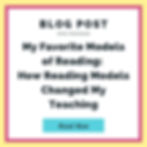My Favorite Models of Reading: How Reading Models Changed My Teaching
- Serena Readhead
- Feb 20, 2024
- 4 min read

Models of Reading...what are they and how can they help? Learning about a few reading models completely transformed the way that I teach reading in the classroom. These visuals were immensely powerful in helping me think about the reading process for my students and the scaffolds they need to become successful readers.
So, what are reading models?
Reading models are usually found in the academic research sphere (think professors, PhDs, psychology and education university programs) and not so much in schools and professional developments, but I'm advocating for a change here! And I think the push for teachers being trained in the science of reading is helping.
Models of reading are theoretical frameworks that aim to explain how people comprehend written text. They help us understand the cognitive processes involved in reading and to develop strategies for improving reading instruction and literacy outcomes.
There are many different models of reading, and if I were a professor I'm sure I'd be aware of them all and have a great understanding of them. But I'm not. I'm a practitioner, a classroom teacher, interventionist, now homeschooling mom (who still works in the schools coaching teachers in reading). And so I know and understand just a few of these models, but the few that I've selected gave me a good visual way to understand the reading process and what my students need.
I'm going to walk you through multiple models of reading that have shaped my assessments, analyzing student data, and instruction. I'll take you through them in the order that I was introduced to them. Conveniently this order started with the simplest and moved to the more complex, allowing my knowledge of reading processes and instruction to grow steadily and build upon itself.
Models of Reading
The Simple View of Reading
Eight years ago I was introduced to the Simple View of Reading and what an AHA! moment it was for me. It broke down the reading process into such simple terms. Here it is:
word recognition x language comprehension = reading
When assessing my students for reading, I began to view their strengths and struggles through this framework.
Are they able to comprehend the story when I read out loud, but not when they read the words themselves? I need to help them with word recognition.
Can they read the words on the page, but can't answer any questions about the text? I need to help them with language comprehension.
This was my first baby steps towards targeted reading instruction and intervention. Immediately upon learning about this model I began to see positive, impactful changes in my approach to assessing students, grouping students, and instructing students.
Scarborough's Reading Rope
Now we step it up the complexness of the reading process. Scarborough's Reading Rope takes the simple view of reading and goes in depth about what word recognition and language comprehension entail. I love the visual that this model provides and the way that it breaks down the components of skilled reading in such a clear, succinct way.

So, after being introduced to the Reading Rope model, I began to think about the assessments and instruction I was providing my students.
When it came to word recognition difficulties, where were my students truly struggling? Were they missing that foundation of phonological awareness? Had they not orthographically mapped the words yet? Are there gaps in their phonics instruction and they do not know certain sound spelling patterns?
And for those struggling with language comprehension, what was the root of their difficulties? Did they not have knowledge about genres and text structures and therefore struggled to organize the content and make predictions while reading? Did they have a limited vocabulary, making comprehending the text a challenge? Maybe they struggled with verbal reasoning or lacked background knowledge on a subject and could not infer what the author was trying to convey.
Understanding these critical components of the reading process allowed me to get to the root of my students struggles, and recognize and build on their areas of strength. Additionally, when planning whole group reading lessons, I often referenced these models to make sure I was incorporating instruction that supported students in all the strands of the rope, leading to proficient reading. When we can be this intentional with our instruction, we are setting every student up for success.
The Active View of Reading
The Active View of Reading is the latest model of reading that I've come across. This model is very similar to Scarborough's Reading Rope and the Simple View of Reading in that it has detailed word recognition and language comprehension components. Where it differs, and expands upon the other two models, is that it also includes a component called "Active Self Regulation."
Nell Duke and Kelly Cartwright (2021) created this model and in their research they found that readers not only use word recognition and language comprehension skills to read, successful readers also use self regulation skills. Self-regulation refers to the reader's ability to monitor and control their cognitive processes and behaviors during reading. These processes allow readers to regulate their comprehension, attention, motivation, and problem-solving abilities as they engage with text.

I'm still giving this one some thought, considering how I can support students self-regulation and executive function skills in the classroom. So as I learn more and research more, I'll continue to share what I find and try here!
And those are the three reading models that have guided and supported my instruction the most over the past 8 years. I hope they help shape your instruction as much as they've shaped mine! Happy Reading Folks!
